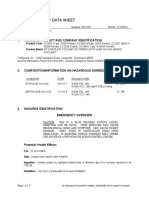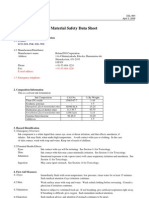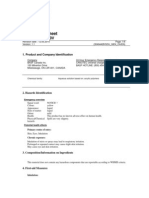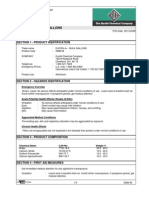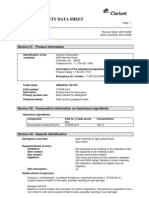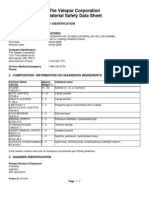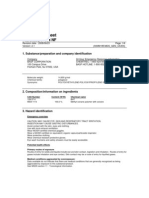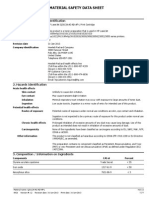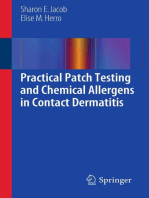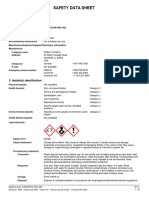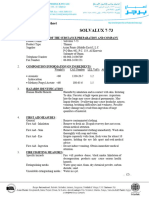0 ratings0% found this document useful (0 votes)
94 viewsPrime SP Developer Working Solution
Prime SP Developer Working Solution
Uploaded by
elsokukabaThis document summarizes the hazards and composition of a developer replenisher solution. It contains diethylene glycol, which can cause kidney damage if ingested, and a dye compound that may cause allergic skin reactions. The solution is an amber liquid with a slight amine odor. It is completely water soluble and has a pH of 10.8. Precautions are needed to prevent prolonged skin or eye contact through use of proper ventilation, gloves, and eye protection.
Copyright:
© All Rights Reserved
Available Formats
Download as PDF, TXT or read online from Scribd
Prime SP Developer Working Solution
Prime SP Developer Working Solution
Uploaded by
elsokukaba0 ratings0% found this document useful (0 votes)
94 views7 pagesThis document summarizes the hazards and composition of a developer replenisher solution. It contains diethylene glycol, which can cause kidney damage if ingested, and a dye compound that may cause allergic skin reactions. The solution is an amber liquid with a slight amine odor. It is completely water soluble and has a pH of 10.8. Precautions are needed to prevent prolonged skin or eye contact through use of proper ventilation, gloves, and eye protection.
Original Description:
Prime SP Developer Working Solution
Copyright
© © All Rights Reserved
Available Formats
PDF, TXT or read online from Scribd
Share this document
Did you find this document useful?
Is this content inappropriate?
This document summarizes the hazards and composition of a developer replenisher solution. It contains diethylene glycol, which can cause kidney damage if ingested, and a dye compound that may cause allergic skin reactions. The solution is an amber liquid with a slight amine odor. It is completely water soluble and has a pH of 10.8. Precautions are needed to prevent prolonged skin or eye contact through use of proper ventilation, gloves, and eye protection.
Copyright:
© All Rights Reserved
Available Formats
Download as PDF, TXT or read online from Scribd
Download as pdf or txt
0 ratings0% found this document useful (0 votes)
94 views7 pagesPrime SP Developer Working Solution
Prime SP Developer Working Solution
Uploaded by
elsokukabaThis document summarizes the hazards and composition of a developer replenisher solution. It contains diethylene glycol, which can cause kidney damage if ingested, and a dye compound that may cause allergic skin reactions. The solution is an amber liquid with a slight amine odor. It is completely water soluble and has a pH of 10.8. Precautions are needed to prevent prolonged skin or eye contact through use of proper ventilation, gloves, and eye protection.
Copyright:
© All Rights Reserved
Available Formats
Download as PDF, TXT or read online from Scribd
Download as pdf or txt
You are on page 1of 7
Material Safety Data Sheet
Revision Date: 09/10/2010
000000009368/Version: 1.3
Print Date: 07/23/2011
Page: 1/7
1. Identification of the substance/mixture and of the company/undertaking
Product name: KODAK EKTACOLOR PRIME SP Developer Replenisher LORR, Working solution
Product code: 8644809 - Working solution
Supplier: EASTMAN KODAK COMPANY, 343 State Street, Rochester, New York 14650
For Emergency Health, Safety & Environmental Information, call (585) 722-5151 (USA)
For further information about this product, call (800) 242-2424.
Synonyms: None.
2. Hazards identification
CONTAINS: Diethylene glycol (111-46-6), 4-(N-ethyl-N-2-methanesulphonylaminoethyl)-2-
methylphenylenediamine (92-09-1)
WARNING!
HARMFUL IF SWALLOWED
MAY CAUSE ALLERGIC SKIN REACTION
CAN CAUSE KIDNEY DAMAGE AND CNS EFFECTS FOLLOWING INGESTION
HMIS III Hazard Ratings: Health - 2*, Flammability - 0, Reactivity (Stability) - 0
NFPA Hazard Ratings: Health - 2, Flammability - 0, Instability - 0
NOTE: HMIS III and NFPA 704 (2007) hazard indexes involve data review and interpretation that may
vary among companies. They are intended only for rapid, general identification of the magnitude of the
potential hazards. To adequately address safe handling, ALL information in this MSDS must be
considered.
3. Composition/information on ingredients
Weight
percent
Components - (CAS-No.)
5 - 10 Diethylene glycol (111-46-6)
1 - 5 Potassium carbonate (584-08-7)
0.1 - < 1 4-(N-ethyl-N-2-methanesulphonylaminoethyl)-2-methylphenylenediamine (92-09-1)
4. First aid measures
Inhalation: If inhaled, remove to fresh air. Get medical attention if symptoms occur.
Eyes: Any material that contacts the eye should be washed out immediately with water. Get medical
attention if symptoms occur.
Material Safety Data Sheet
Revision Date: 09/10/2010
000000009368/Version: 1.3
Print Date: 07/23/2011
Page: 2/7
Skin: In case of contact, immediately flush skin with plenty of water for at least 15 minutes while
removing contaminated clothing and shoes. Get medical attention if symptoms occur. Wash contaminated
clothing before re-use. Destroy or thoroughly clean contaminated shoes.
Ingestion: If swallowed, only induce vomiting as directed by medical personnel. Never give anything by
mouth to an unconscious person. Call a physician or poison control centre immediately.
5. Fire-fighting measures
Extinguishing Media: Use extinguishing measures that are appropriate to local circumstances and the
surrounding environment.
Special Fire-Fighting Procedures: None (noncombustible)
Hazardous Combustion Products: None (noncombustible)
Unusual Fire and Explosion Hazards: None.
6. Accidental release measures
Absorb spill with vermiculite or other inert material, then place in a container for chemical waste. Clean
surface thoroughly to remove residual contamination.
7. Handling and storage
Personal precautions: Avoid prolonged or repeated breathing of mist or vapour. Avoid contact with
eyes, skin, and clothing. Use only with adequate ventilation. Wash thoroughly after handling.
Prevention of Fire and Explosion: No special technical protective measures required.
Storage: Keep container tightly closed.
8. Exposure controls/personal protection
Occupational exposure controls: Not established
Ventilation: Good general ventilation should be used. Ventilation should be sufficient so that applicable
occupational exposure limits are not exceeded. Ventilation rates should be matched to conditions.
Supplementary local exhaust ventilation, closed systems, or respiratory protection may be needed in
special circumstances.
Respiratory protection: None should be needed.
Eye protection: Wear safety glasses with side shields (or goggles).
Hand protection: Wear impervious gloves and protective clothing appropriate for the risk of exposure.
9. Physical and chemical properties
Physical form: liquid
Material Safety Data Sheet
Revision Date: 09/10/2010
000000009368/Version: 1.3
Print Date: 07/23/2011
Page: 3/7
Colour: amber
Odour: slight amine
Specific gravity: 1.028
Vapour pressure: 24 mbar (18.0 mm Hg)
Vapour density: 0.6
Volatile fraction by weight: 95 - 100 %
Boiling point/boiling range: > 35 C (> 95.0 F) (estimated)
Water solubility: completely soluble
pH: 10.8
Flash point: does not flash
10. Stability and reactivity
Stability: Stable under normal conditions.
Incompatibility: None with common materials and contaminants with which the material may reasonably
come into contact.
Hazardous decomposition products: None under normal conditions of use.
Hazardous Polymerization: Hazardous polymerisation does not occur.
11. Toxicological information
Effects of Exposure
General advice:
Contains: Diethylene glycol. Can cause kidney damage and CNS effects following ingestion.
Repeated oral exposure to high doses can cause liver damage.
Contains: 4-(N-ethyl-N-2-methanesulphonylaminoethyl)-2-methylphenylenediamine. May
cause kidney damage based on animal data.
Inhalation: Expected to be a low hazard for recommended handling.
Eyes: No specific hazard known. May cause transient irritation.
Skin: May cause allergic skin reaction.
Ingestion: Harmful if swallowed. Can cause kidney damage and CNS effects following ingestion.
Material Safety Data Sheet
Revision Date: 09/10/2010
000000009368/Version: 1.3
Print Date: 07/23/2011
Page: 4/7
Data for Diethylene glycol (CAS 111-46-6):
Acute Toxicity Data:
Oral LD50 (rat): > 3,200 mg/kg
Inhalation LCLo (mouse): 130 mg/m3 / 2 hr
Dermal LD50 (rabbit): > 10,000 mg/kg
Skin irritation: slight to moderate
Eye irritation: mild
Mutagenicity/Genotoxicity Data:
Ames test: negative (in presence and absence of activation)
Data for Potassium carbonate (CAS 584-08-7):
Acute Toxicity Data:
Oral LD50 (rat): 1,870 mg/kg
Data for 4-(N-ethyl-N-2-methanesulphonylaminoethyl)-2-methylphenylenediamine (CAS 92-09-1):
Acute Toxicity Data:
Oral LD50 (rat): 200 mg/kg
Skin Sensitization (guinea pig): moderate (Causes sensitization on guinea-pigs.)
Definitions for the following section(s): LOEL =lowest-observed-effect level, LOAEL = lowest-
observed-adverse-effect, NOAEL = no observed-adverse-effect level, NOEL =no-observed-effect
level.
Carcinogenicity:
Dermal study (mouse, 2 years): NOEL; 62 mg/kg/day (only dose tested)
12. Ecological information
The following properties are ESTIMATED from the components of the preparations.
Potential Toxicity:
Toxicity to fish (LC50): 10 - 100 mg/l
Toxicity to daphnia (EC50): 10 - 100 mg/l
Persistence and degradability: Readily biodegradable.
13. Disposal considerations
Discharge, treatment, or disposal may be subject to federal, state, commonwealth, provincial, or local
laws. Since emptied containers retain product residue, follow label warnings even after container is
emptied.
14. Transport information
Material Safety Data Sheet
Revision Date: 09/10/2010
000000009368/Version: 1.3
Print Date: 07/23/2011
Page: 5/7
Not regulated for all modes of transportation.
For more transportation information, go to: www.kodak.com/go/ship.
15. Regulatory information
Notification status
Regulatory List Notification status
TSCA Not all listed
DSL Not all listed
NDSL Listed
EINECS Not all listed
ELINCS None listed
NLP None listed
AICS Not all listed
IECS Not all listed
ENCS Not all listed
ECI Not all listed
NZIoC Not all listed
PICCS Not all listed
"Not all listed" indicates one or more component is either not on the public Inventory or is subject to
exemption requirements. If additional information is needed contact Kodak.
Other regulations
American Conference of Governmental Industrial Hygienists
(ACGIH):
No component of this product present
at levels greater than or equal to
0.1% is identified as a carcinogen
or potential carcinogen by ACGIH.
International Agency for Research on Cancer (IARC): No component of this product present
at levels greater than or equal to
0.1% is identified as probable,
possible or confirmed human
carcinogen by IARC.
U.S. National Toxicology Program (NTP): No component of this product present
at levels greater than or equal to
0.1% is identified as a known or
anticipated carcinogen by NTP.
U.S. Occupational Safety and Health Administration
(OSHA):
No component of this product present
at levels greater than or equal to
0.1% is identified as a carcinogen
Material Safety Data Sheet
Revision Date: 09/10/2010
000000009368/Version: 1.3
Print Date: 07/23/2011
Page: 6/7
or potential carcinogen by OSHA.
California Prop. 65 This product does not contain any
chemicals known to State of
California to cause cancer, birth
defects, or any other reproductive
harm.
U.S. - CERCLA/SARA (40 CFR 302.4 Designation of
hazardous substances):
No components of this product are
subject to the SARA Section 302
(40 CFR 302.4) reporting
requirements.
U.S. - CERCLA/SARA - Section 302 (40 CFR 355
Appendices A and B - The List of Extremely Hazardous
Substances and Their Threshold Planning Quantities):
No components of this product are
subject to the SARA Section 302
(40 CFR 355) reporting
requirements.
U.S. - CERCLA/SARA - Section 313 (40 CFR 372.65
Toxic Chemical Release Reporting):
No components of this product are
subject to the SARA Section 313
(40 CFR 372.65) reporting
requirements.
U.S. - California - 8 CCR Section 339 - Director's List of
Hazardous Substances:
No components found on the California
Director's List of Hazardous
Substances.
U.S. - California - 8 CCR Section 5200-5220 - Specifically
Regulated Carcinogens:
No components found on the California
Specifically Regulated
Carcinogens List.
U.S. - California - 8 CCR Section 5203 Carcinogens: No components found on the California
Section 5203 Carcinogens List.
U.S. - California - 8 CCR Section 5209 Carcinogens: No components found on the California
Section 5209 Carcinogens List.
U.S. - Massachusetts - General Law Chapter 111F (MGL c
111F) - Hazardous Substances Disclosure by
Employers (a.k.a. Right to Know Law):
No components regulated under the
Massachusetts Hazardous
Substances Disclosure by
Employers Law.
U.S. - Minnesota Employee Right-to-Know (5206.0400,
Subpart 5. List of Hazardous Substances):
Diethylene glycol
U.S. - New Jersey - Worker and Community Right to Know
Act (N.J.S.A. 34:5A-1):
No components regulated under the
New Jersey Worker and
Community Right-to-Know Act.
U.S. - Pennsylvania - Part XIII. Worker and Community
Right-to-Know Act (Chapters 301-323):
Diethylene glycol, Water
U.S. - Rhode Island - Title 28 Labor and Labor Relations
(Chapters 28-21 Hazardous Substance Right-to-Know
Act):
Diethylene glycol
16. Other information
Material Safety Data Sheet
Revision Date: 09/10/2010
000000009368/Version: 1.3
Print Date: 07/23/2011
Page: 7/7
The data below reflects current legislative requirements whereas the product in your possession may
carry a different version of the label depending on the date of manufacture.
US/Canadian Label Statements:
KODAK EKTACOLOR PRIME SP Developer Replenisher LORR, Working solution
CONTAINS: Diethylene glycol (111-46-6), 4-(N-ethyl-N-2-methanesulphonylaminoethyl)-2-
methylphenylenediamine (92-09-1).
WARNING! HARMFUL IF SWALLOWED. MAY CAUSE ALLERGIC SKIN REACTION. CAN CAUSE
KIDNEY DAMAGE AND CNS EFFECTS FOLLOWING INGESTION.
Avoid prolonged or repeated breathing of mist or vapour. Avoid contact with eyes, skin, and clothing. Use
only with adequate ventilation. Wash thoroughly after handling. FIRST AID: If inhaled, remove to fresh
air. Get medical attention if symptoms occur. Any material that contacts the eye should be washed out
immediately with water. Get medical attention if symptoms occur. In case of contact, immediately flush
skin with plenty of water for at least 15 minutes while removing contaminated clothing and shoes. Get
medical attention if symptoms occur. Wash contaminated clothing before re-use. Destroy or thoroughly
clean contaminated shoes. If swallowed, only induce vomiting as directed by medical personnel. Never
give anything by mouth to an unconscious person. Call a physician or poison control centre immediately.
Keep out of reach of children. Do not handle or use until safety precautions in Material Safety Data Sheet
(MSDS) have been read and understood. Since emptied containers retain product residue, follow label
warnings even after container is emptied. IN CASE OF FIRE: Use extinguishing measures that are
appropriate to local circumstances and the surrounding environment. IN CASE OF SPILL: Absorb spill
with vermiculite or other inert material, then place in a container for chemical waste. Clean surface
thoroughly to remove residual contamination. Additional Components Include: Water (7732-18-5), 4-(N-
ethyl-N-2-methanesulphonylaminoethyl)-2-methylphenylenediamine (92-09-1), Substituted stilbene (not
applicable).
The information contained herein is furnished without warranty of any kind. Users should consider these
data only as a supplement to other information gathered by them and must make independent
determinations of suitability and completeness of information from all sources to assure proper use and
disposal of these materials and the safety and health of employees and customers and the protection of
the environment. The information relating to the working solution is for guidance purposes only, and is
based on correct mixing and use of the product according to instructions.
R-1, S-2, F-0, C-0
You might also like
- MSDS E-Liquid With 0.0 NicotineDocument6 pagesMSDS E-Liquid With 0.0 Nicotinejawaidchemicals100% (1)
- The Health & Safety Guide for Film, TV & Theater, Second EditionFrom EverandThe Health & Safety Guide for Film, TV & Theater, Second EditionRating: 4 out of 5 stars4/5 (1)
- SISON REVIEW CENTER: Chemistry Technician Boards Review Chemical Waste Management: 01. Environmental Laws and Regulations in The PhilippinesDocument19 pagesSISON REVIEW CENTER: Chemistry Technician Boards Review Chemical Waste Management: 01. Environmental Laws and Regulations in The PhilippinesJohn Michael TolentinoNo ratings yet
- DK50 Developer Parts ABDocument15 pagesDK50 Developer Parts ABedu3ipbNo ratings yet
- Msds Pig IronDocument6 pagesMsds Pig Ironcampag12350% (2)
- Es Compleat Coolant Eg Premix - MSDS - Lt16587aDocument6 pagesEs Compleat Coolant Eg Premix - MSDS - Lt16587aCesar G.No ratings yet
- Chemicals Zetag MSDS Inverse Emulsion Zetag 8858 FSB - 0510Document6 pagesChemicals Zetag MSDS Inverse Emulsion Zetag 8858 FSB - 0510PromagEnviro.comNo ratings yet
- Clarinet - Frank Weber - First Division Band Method PDFDocument36 pagesClarinet - Frank Weber - First Division Band Method PDFelsokukabaNo ratings yet
- Ektacolor RA Developer StarterDocument6 pagesEktacolor RA Developer StarterelsokukabaNo ratings yet
- MSDS GenaminDocument8 pagesMSDS GenaminNever Mauricio Ortiz AlvarezNo ratings yet
- Prime SP Bleach Fix Working SolutionDocument7 pagesPrime SP Bleach Fix Working SolutionelsokukabaNo ratings yet
- MSDS Esl-WhDocument4 pagesMSDS Esl-WhankitleedsNo ratings yet
- Msds Brake Fluids Federal-MogulDocument9 pagesMsds Brake Fluids Federal-MogulElías VillegasNo ratings yet
- Msds Cefuroxime Sodium Eli LillyDocument7 pagesMsds Cefuroxime Sodium Eli Lillycupidvishu123No ratings yet
- Chemicals Zetag MSDS Organic Coagulants Magnafloc LT 7992 - 0710Document6 pagesChemicals Zetag MSDS Organic Coagulants Magnafloc LT 7992 - 0710PromagEnviro.comNo ratings yet
- Material Safety Data Sheet: Carbopol 920 10%Document6 pagesMaterial Safety Data Sheet: Carbopol 920 10%MTech ProjectNo ratings yet
- Chemicals Zetag MSDS Antiprex N 40V - 0510Document6 pagesChemicals Zetag MSDS Antiprex N 40V - 0510PromagEnviro.comNo ratings yet
- Violeta Metilo EnglishDocument7 pagesVioleta Metilo EnglishMarielle RiveraNo ratings yet
- Handsan-19 Gel MSDSDocument5 pagesHandsan-19 Gel MSDSpabianmarsNo ratings yet
- Material Safety Data Sheet: Revision Date: 06/20/2003 Print DateDocument5 pagesMaterial Safety Data Sheet: Revision Date: 06/20/2003 Print DatejnilanNo ratings yet
- Msds MFG 4141 - MoldReleaseConctrtDocument3 pagesMsds MFG 4141 - MoldReleaseConctrtJean ValjeanNo ratings yet
- Material Safety Data Sheet: Section 1 - Chemical Product and Company IdentificationDocument7 pagesMaterial Safety Data Sheet: Section 1 - Chemical Product and Company IdentificationLuthfi Prananta WibawaNo ratings yet
- Material Safety Data Sheet - Docx EtilenglikolDocument7 pagesMaterial Safety Data Sheet - Docx EtilenglikolHasna KhoirunnisaNo ratings yet
- Material Safety Data Sheet Ethylene Glycol Monoethyl Ether Section 1 - Chemical Product and Company IdentificationDocument7 pagesMaterial Safety Data Sheet Ethylene Glycol Monoethyl Ether Section 1 - Chemical Product and Company IdentificationFay BcvNo ratings yet
- Neogen® Filter SKU No. 6555 - MSDSDocument3 pagesNeogen® Filter SKU No. 6555 - MSDSmrimzan.teqzaNo ratings yet
- Chemicals Zetag MSDS Powder Magnafloc 338 - 0510Document6 pagesChemicals Zetag MSDS Powder Magnafloc 338 - 0510PromagEnviro.comNo ratings yet
- Sullube American Chemical MSDS - EnglishDocument6 pagesSullube American Chemical MSDS - EnglishMod Kaewdaeng100% (2)
- Material Safety Data Sheet: (Acute and Chronic)Document4 pagesMaterial Safety Data Sheet: (Acute and Chronic)Muhammad Andhika AlfaridziNo ratings yet
- Chemicals Zetag MSDS Powder Magnafloc 611 - 0710Document6 pagesChemicals Zetag MSDS Powder Magnafloc 611 - 0710PromagEnviro.com100% (1)
- Chemicals Zetag MSDS Organic Coagulants Magnafloc LT 7981 - 0710Document6 pagesChemicals Zetag MSDS Organic Coagulants Magnafloc LT 7981 - 0710PromagEnviro.comNo ratings yet
- MSDS - Stanbio Kolesterol TotalDocument4 pagesMSDS - Stanbio Kolesterol TotalDoni Eka PrasetiyoNo ratings yet
- Eucon A+ MsdsDocument5 pagesEucon A+ MsdsCarlo PizarroNo ratings yet
- Santovac 5 SDS PDFDocument5 pagesSantovac 5 SDS PDFmanish_keswani01No ratings yet
- Loctite Nickel High Purity MSDSDocument5 pagesLoctite Nickel High Purity MSDSmarciofelipessantosNo ratings yet
- MSDS-HbA1c Calibrator-2019-非危-1.4Document7 pagesMSDS-HbA1c Calibrator-2019-非危-1.4laboratorium rsst klatenNo ratings yet
- Genapol UD 070Document7 pagesGenapol UD 070Amy ZahraNo ratings yet
- Seachem Laboratories, Inc. Safety Data SheetDocument8 pagesSeachem Laboratories, Inc. Safety Data SheetJorge Restrepo HernandezNo ratings yet
- Chemicals Zetag MSDS Magnasol 2000 G - 0710Document6 pagesChemicals Zetag MSDS Magnasol 2000 G - 0710PromagEnviro.comNo ratings yet
- JD Sunlight Liq DishDocument4 pagesJD Sunlight Liq DishmansuraquelNo ratings yet
- Alginate RemoverDocument4 pagesAlginate RemoveraleksovNo ratings yet
- Corn OilDocument5 pagesCorn OilRino Anugraha TriatmajaNo ratings yet
- MSDS FDC Yellow No%6 Aluminum Lake 15-18Document6 pagesMSDS FDC Yellow No%6 Aluminum Lake 15-18Vanti_805No ratings yet
- D 6000Document6 pagesD 6000os_ja@hotmail.comNo ratings yet
- StromatolyserDocument3 pagesStromatolyserk3 rsch100% (1)
- MSDS AAY0953.PDF - Topcoat YellowDocument7 pagesMSDS AAY0953.PDF - Topcoat YellowdevdossbNo ratings yet
- Msds Crystal VioletDocument7 pagesMsds Crystal VioletjbjsabuNo ratings yet
- ED - 13 - Supelco 37 Component FAME MixDocument8 pagesED - 13 - Supelco 37 Component FAME MixbenjanunezgNo ratings yet
- MSDS - pd.29 01 Cetyl AlcoholDocument7 pagesMSDS - pd.29 01 Cetyl AlcoholldfgkdlgNo ratings yet
- Material Safety Data Sheet: Chromate Industrial CorporationDocument4 pagesMaterial Safety Data Sheet: Chromate Industrial CorporationJulio Alex PadangNo ratings yet
- Safety Data Sheet: PluronicDocument6 pagesSafety Data Sheet: PluronicsanalpsNo ratings yet
- Cartridge HP 12A EspecificacionesDocument6 pagesCartridge HP 12A Especificacioneskarl_frederickNo ratings yet
- MSDS of Wet ChemicalDocument4 pagesMSDS of Wet ChemicalParth SarthiNo ratings yet
- Naval JellyDocument4 pagesNaval JellyjohnsopranaNo ratings yet
- MSDS - Stanbio GlukosaDocument4 pagesMSDS - Stanbio GlukosaDoni Eka PrasetiyoNo ratings yet
- Para Chloro Nitro BenzeneDocument8 pagesPara Chloro Nitro BenzeneAnish PalNo ratings yet
- Bioesque SDS Disinfectant BotanicalDocument3 pagesBioesque SDS Disinfectant BotanicalNed MNo ratings yet
- Manual de Compresor 24134728Document40 pagesManual de Compresor 24134728Carlos Apolo RamirezNo ratings yet
- Material Safety Data Sheet: Dipropylene Glycol MSDSDocument6 pagesMaterial Safety Data Sheet: Dipropylene Glycol MSDSanpuselvi125No ratings yet
- Material Safety Data Sheet: Guangzhou Botny Chemical Co.,LtdDocument5 pagesMaterial Safety Data Sheet: Guangzhou Botny Chemical Co.,LtdpedroNo ratings yet
- A Consumerýs Dictionary of Household, Yard and Office Chemicals: Complete Information About Harmful and Desirable Chemicals Found in Everyday Home Products, Yard Poisons, and Office PollutersFrom EverandA Consumerýs Dictionary of Household, Yard and Office Chemicals: Complete Information About Harmful and Desirable Chemicals Found in Everyday Home Products, Yard Poisons, and Office PollutersNo ratings yet
- Practical Patch Testing and Chemical Allergens in Contact DermatitisFrom EverandPractical Patch Testing and Chemical Allergens in Contact DermatitisNo ratings yet
- Color Rendering Index White Paper Ron Kubara NoritsuDocument7 pagesColor Rendering Index White Paper Ron Kubara NoritsuelsokukabaNo ratings yet
- Copper Pipe Test For Silver RecoveryDocument7 pagesCopper Pipe Test For Silver RecoveryelsokukabaNo ratings yet
- Kodak Process Monitoring Y55 ChartDocument1 pageKodak Process Monitoring Y55 ChartelsokukabaNo ratings yet
- IS Unit 1Document25 pagesIS Unit 1Ishwarya ManivannanNo ratings yet
- Poly Aluminium Chloride PDFDocument4 pagesPoly Aluminium Chloride PDFshoyebNo ratings yet
- Heubach SDS Fat Orange R 01 European Community EnglishDocument12 pagesHeubach SDS Fat Orange R 01 European Community Englishprashantgarg0510No ratings yet
- 014 SDS ForeE-7Bio. ForeE-8BioDocument10 pages014 SDS ForeE-7Bio. ForeE-8BioNinaNo ratings yet
- Material Safety Data Sheet Liquid Soap JiniDocument4 pagesMaterial Safety Data Sheet Liquid Soap JiniRocky BisNo ratings yet
- Toxicology StacyDocument633 pagesToxicology StacyRevi RinaldiNo ratings yet
- MSDS of YFK-CHINACLAYDocument9 pagesMSDS of YFK-CHINACLAYSeshagiri KalyanasundaramNo ratings yet
- Stannous Chloride MSDS PDFDocument6 pagesStannous Chloride MSDS PDFMuhammadLukmanulHakimNo ratings yet
- MSDS DefoamDocument4 pagesMSDS DefoamEdigel RebolledoNo ratings yet
- 03-Hand Soap MSDSDocument8 pages03-Hand Soap MSDSshamroz khanNo ratings yet
- Oxicology: Stony Brook University, School of Health Technology and Management - HAD 432Document26 pagesOxicology: Stony Brook University, School of Health Technology and Management - HAD 432dvoyevodNo ratings yet
- SDS Penguard Midcoat Comp ADocument13 pagesSDS Penguard Midcoat Comp AK3L AJGNo ratings yet
- Product and Company IdentificationDocument6 pagesProduct and Company IdentificationJc RcNo ratings yet
- Magnaseal Plus - MSP-40 MSDS - Project Sales CorpDocument16 pagesMagnaseal Plus - MSP-40 MSDS - Project Sales CorpProject Sales CorpNo ratings yet
- Safety Data Sheet Prepared To UN GHS Revision 3: Date Printed: 25/06/2018 Product: 520 CLEARDocument8 pagesSafety Data Sheet Prepared To UN GHS Revision 3: Date Printed: 25/06/2018 Product: 520 CLEARKOKOLENo ratings yet
- Cdi 19 Group 3Document14 pagesCdi 19 Group 3Licaycay StiffanyNo ratings yet
- Solfac 050 EW - MSDS IndDocument11 pagesSolfac 050 EW - MSDS Ind20abhayNo ratings yet
- Anh văn chuyên ngành hóa học và thực phẩmDocument1,784 pagesAnh văn chuyên ngành hóa học và thực phẩmTìm Nơi Bình YênNo ratings yet
- Safety Data Sheet: Chevron (Philippines) Unleaded GasolineDocument12 pagesSafety Data Sheet: Chevron (Philippines) Unleaded GasolineRocky BusuegoNo ratings yet
- Msds MagsulDocument8 pagesMsds Magsuldiantika prameswaraNo ratings yet
- Pyrocrete 241 MSDSDocument10 pagesPyrocrete 241 MSDSOrellana Zeballos Luis CristianNo ratings yet
- pp2 Final Risk Assessment W App 11082016 PDFDocument723 pagespp2 Final Risk Assessment W App 11082016 PDFnaomi vinartaNo ratings yet
- SDS(Haematoxylin)Document12 pagesSDS(Haematoxylin)rut4soloNo ratings yet
- Stepgrow RM-1002Document8 pagesStepgrow RM-1002Alfredo MéndezNo ratings yet
- 11Document4 pages11arcon.united1No ratings yet
- PPG MsdsDocument14 pagesPPG MsdsswerNo ratings yet
- Nitrogen Ms DsDocument4 pagesNitrogen Ms DssaddlemanNo ratings yet
- SDS Coolant NALDocument7 pagesSDS Coolant NALAGS PowerNo ratings yet
- Material Safety Data Sheet: Potassium BromateDocument7 pagesMaterial Safety Data Sheet: Potassium BromateGustika AzharNo ratings yet





